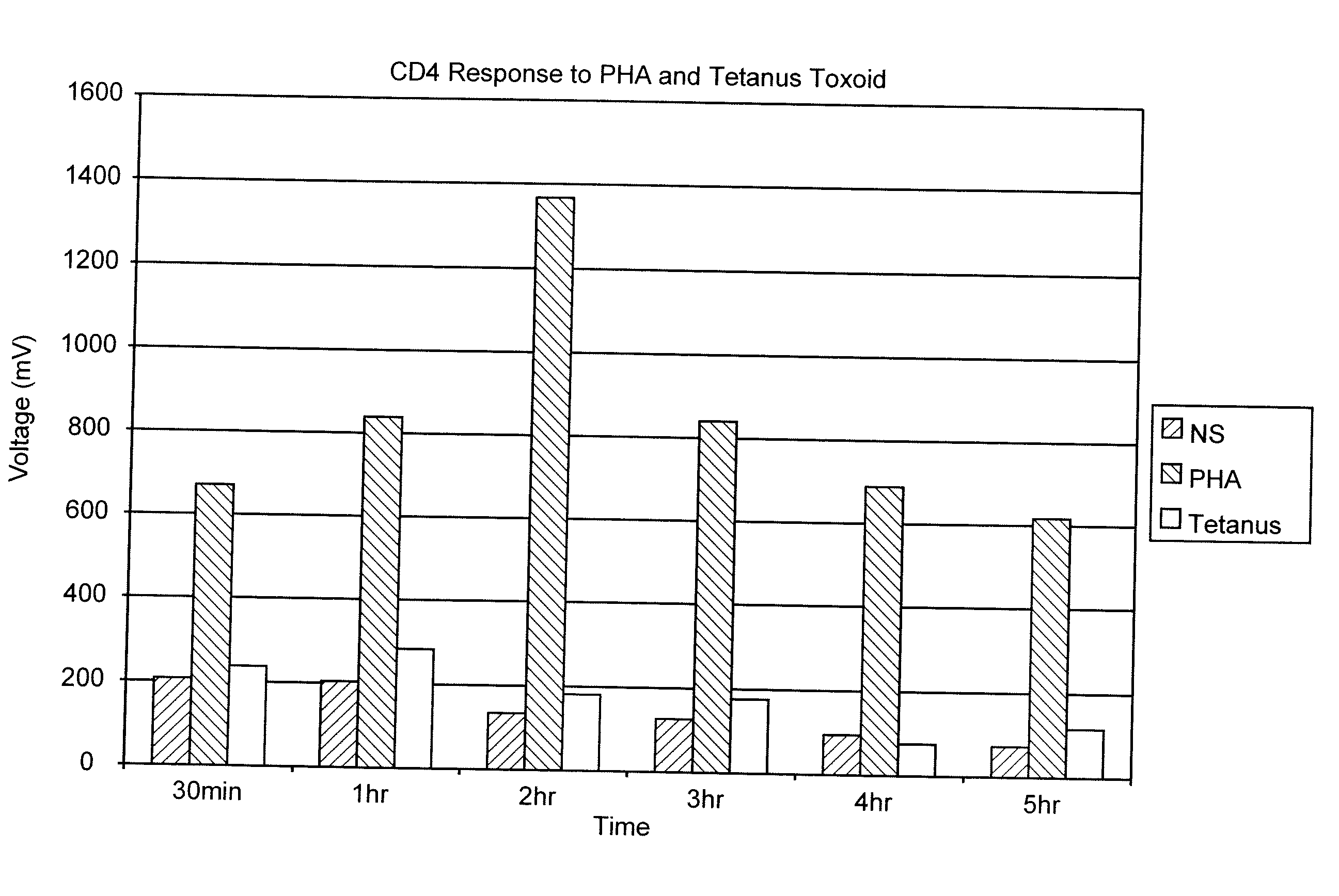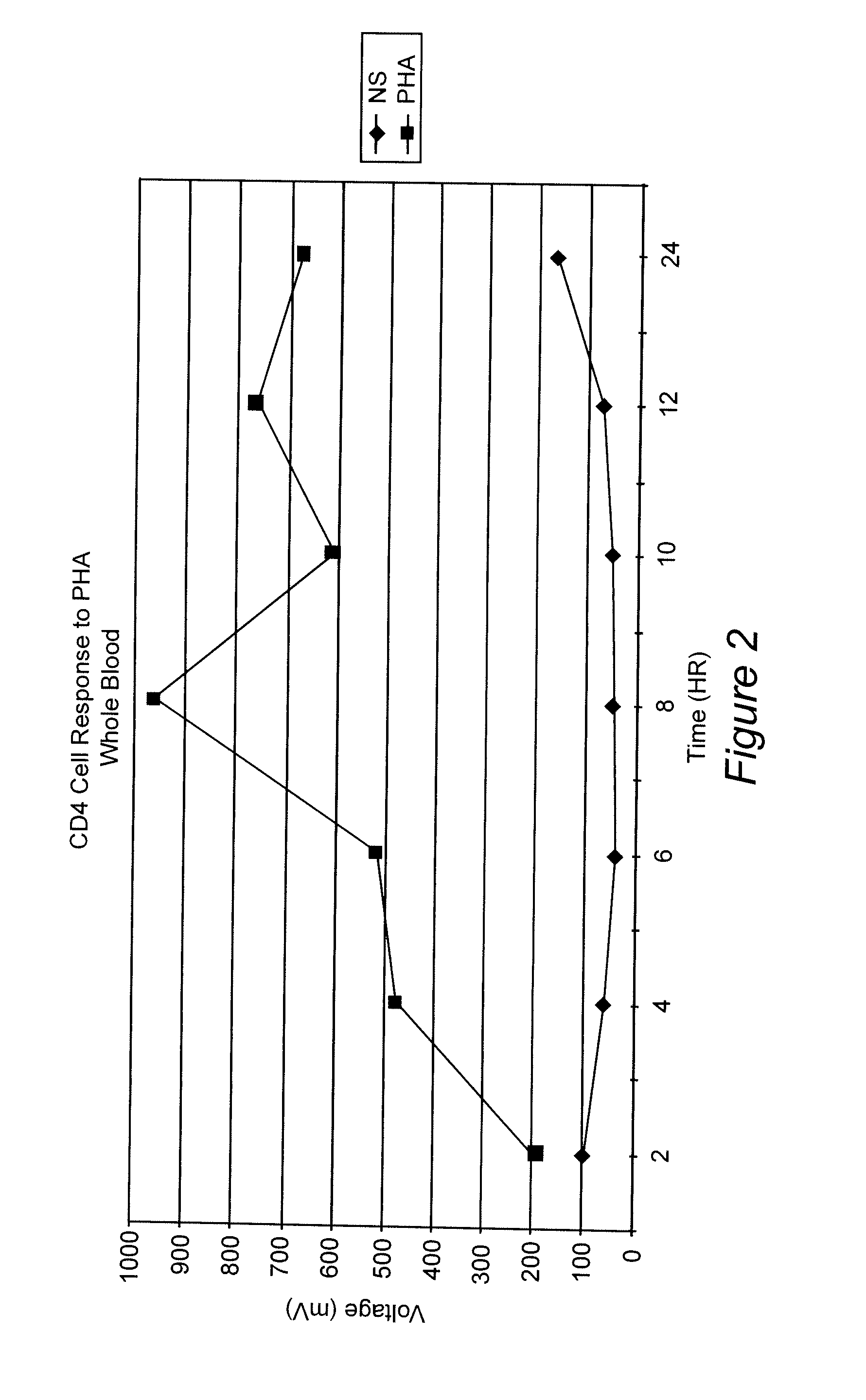Method to confirm immunosuppression in human patients by measuring lymphocyte activation
a technology lymphocyte activation, which is applied in the field of human immunodeficiency virus detection in human patients by measuring lymphocyte activation, can solve the problems of difficult to measure the function of t lymphocytes (t cells) or their response to specific antigens, and the current methods of measuring immune function are tedious, time-consuming, and poorly adapted to the clinical laboratory setting. , to achieve the effect of convenient, reliable and rapid measuremen
- Summary
- Abstract
- Description
- Claims
- Application Information
AI Technical Summary
Benefits of technology
Problems solved by technology
Method used
Image
Examples
example 1
Measurement of the Response of T-Lymphocytes to Phytohemagglutinin (PHA) and Tetanus Toxoid Using Whole Blood as the Sample
[0064] A blood sample was obtained from a normal donor and collected in heparin as an anti-coagulant. Aliquots of the blood were diluted 1:10 in RPMI 1640 cell culture media (Biowhittaker, Walkersville, Md.). Replicates received either no addition, the mitogen PHA (Sigma-Aldrich, St. Louis, MO) at 1%, or the antigen Tetanus Toxoid (University of Massachusetts Medical Center, Jamaica Plains, Mass.) at 1 ug / mL final concentration. Samples were incubated at 37° C. At various time points (30 min, 1 hr, 2 hr, 3 hr, 4 hr and 5 hr), 100 uL of the samples were removed, incubated with paramagnetic beads coated with the binding substance anti-CD4 (Dynal, Oslo, Norway) (20 uL) for 30 minutes at room temperature. The cells and beads were placed next to a permanent magnet that was positioned such that the magnet field was in a direction perpendicular to gravity. Bead:cell c...
example 2
Whole Blood Response After Stimulation With Phytohemmaglutinin (PHA)
[0067] A blood sample was obtained from a normal donor and collected in heparin as an anti-coagulant. Aliquots of the blood were diluted 1:10 in RPMI 1640. Replicates received either no addition or the mitogen PHA at 1% final concentration. Samples were incubated at 37° C. At various time points (2 hr, 4 hr, 6 hr, 8 hr and 24 hr), 100 uL of the samples were removed, incubated with anti-CD4 coated paramagnetic beads (20 uL) for 30 minutes at room temperature. The cells and beads were placed next to a permanent magnet positioned such that the magnetic field was in a direction perpendicular to gravity. Bead:cell complexes were washed (3 times in RPMI 1640) and lysed in a detergent solution. Assay Reagent (luciferin / luciferase) was added to the samples ATP production was determined as described above. FIG. 2 shows the results of this assay. An increase in ATP over background can be seen at all time points. The response...
example 3
T-lymphocyte Response: Co-stimulation with Antigen and Antibody Coated Paramagnetic Particles
[0069] A blood sample was obtained from a normal donor and collected in heparin as an anti-coagulant. Aliquots of the blood (50 uL) were diluted 1:2 in RPMI 1640 and placed into wells of a 96-well microtiter plate. Replicates received either no addition, or the antigen Tetanus Toxoid at 1 μg / mL final concentration plus anti-CD3 / CD28 coated paramagnetic beads (0.5 uL) (Dynal, Oslo, Norway). Samples were incubated for various times (30 min, 1 hr, 2 hr, and 3 hr), at 37° C. After incubation, the 96-well strips were removed and placed in a magnet tray. Bead:cell complexes were washed (3 times in a wash buffer containing 1% BSA) and lysed in a hypotonic solution. An aliquot of the sample (50 uL) was removed to an opaque plate and Assay Reagent (luciferin / luciferase) was added. The samples were read and Relative Light Units were determined. The ATP production was then calculated from an ATP calib...
PUM
 Login to View More
Login to View More Abstract
Description
Claims
Application Information
 Login to View More
Login to View More - R&D
- Intellectual Property
- Life Sciences
- Materials
- Tech Scout
- Unparalleled Data Quality
- Higher Quality Content
- 60% Fewer Hallucinations
Browse by: Latest US Patents, China's latest patents, Technical Efficacy Thesaurus, Application Domain, Technology Topic, Popular Technical Reports.
© 2025 PatSnap. All rights reserved.Legal|Privacy policy|Modern Slavery Act Transparency Statement|Sitemap|About US| Contact US: help@patsnap.com



